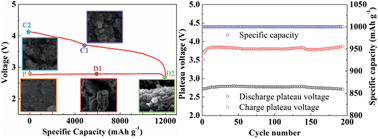N-doped onion-like carbon as an efficient oxygen electrode for long-life Li–O2 battery†
Abstract
Among current rechargeable batteries, the rechargeable lithium–oxygen (Li–O2) battery is a promising energy storage solution for next-generation smart power grids and electric vehicles due to its superior specific energy. However, the properties of the electrocatalyst still limits the rate capability, round-trip efficiency and cycle stability of the Li–O2 battery. In this work, the synthesis of mesoporous, nitrogen-doped, onion-like carbon (N-OLC) with large surface area as a new electrocatalyst for the Li–O2 battery is reported. The catalysts present multiply quasi-spherical concentric sp2 graphitic shells. This remarkable feature of the mesoporous N-OLC not only facilitates the diffusion of lithium ion and oxygen but also delivers many electrocatalytic sites and eventually improves the Li–O2 battery performance, including high round-trip efficiency, high specific capacity, good rate performance and excellent cycle stability at nearly 200 cycles. The possible oxygen electrode reaction mechanism during the discharge and charge processes is proposed on the basis of morphology and structure investigations. This work offers exciting possibilities for the development of heteroatom-doped carbon materials for the improvement of Li–O2 battery performance.


 Please wait while we load your content...
Please wait while we load your content...